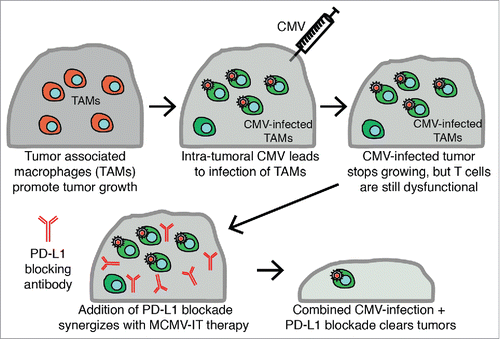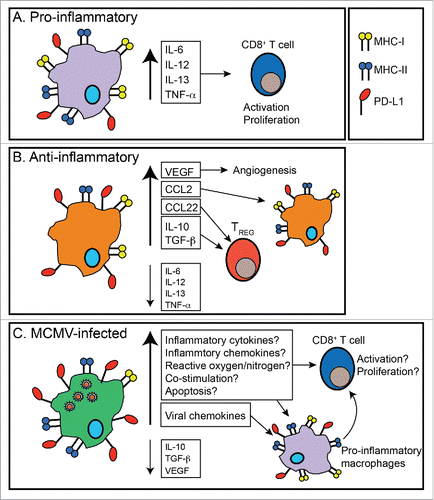Figures & data
Figure 1. Schematic of Intratumoral CMV therapy. Tumor-associated macrophages (TAM) in tumors help to promote and drive tumor growth. After injecting CMV intratumorally, CMV infected TAMs and this correlated with a delay in tumor growth. Combining this intratumoral CMV infection of TAM with anti-PD-L1 therapy synergized to induce clearance of more than 60% of tumors and long-term protection.

Figure 2. Tumor associate macrophage and changes induced by CMV infection. A) Pro-inflammatory tumor associated macrophages (TAM) express high levels of MHC-I, MHC-II and release pro-inflammatory cytokines. These attributes can contribute to T cell activation and proliferation, and subsequent anti-tumor effects. B) Tumor progression is associated with an accumulation of anti-inflammatory TAMs, which express lower levels of MHC-I, MHC-II and proinflammatory cytokines and increase expression of anti inflammatory cytokines, leading to diminished T cell responses. Additionally, anti-inflammatory TAMS release VEGF, which induces angiogenesis, CCL2, which can induce the accumulation of anti-inflammatory macrophages, and CCL22, which can induce TREG infiltration. Together, these attributes contribute to tumor progression. C) After IT infection with MCMV, TAM became infected. CMV infection of macrophages is known to promote a shift toward a more pro-inflammatory phenotype. Additionally, CMV encodes its own virally-encoded chemokines, which attract inflammatory macrophages. Thus, although more work is needed to define the changes in TAM, we hypothesize that MCMV infection of TAMs leads to increased T cell activation and proliferation and increased recruitment of pro-inflammatory macrophages to the tumor. Together, these attributes of TAM MCMV infection may shift the tumor microenvironment from anti-inflammatory to pro-inflammatory.

